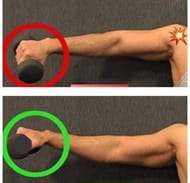The side lateral raise is a simple exercise where you work the shoulder joint and try to isolate the middle head of the deltoid. This is one exercise that will contribute to the overall upper body width. The main function of the middle deltoid is shoulder abduction, i.e. moving the arm away from the body sideways.
When performing this exercise, you want to make sure that you use a weight that you can control at all times with strict form. This is definitely not an exercise where you would want to test your one rep max. Using a heavy weight on this exercise will put immense stress on shoulder joint which can increase the chance of a shoulder injury.
The shoulder joint is an area that is very vulnerable to injury and if you do get injured, it is going to jeopardize most of your upper body training. So, it is really important that you protect your shoulder joint by paying attention to the form, control, and movement of the exercise. Avoid anything that is dynamic or flashy when it comes to the shoulder exercises.
Now, most bodybuilders rotate the shoulder internally at the top of the movement to get more contraction the on the middle deltoid, which depicts a movement of pouring water in a glass from a jug (thumbs down position).
The question remains, it is wise and practical to rotate the shoulders internally at the top of the movement. Does it really have the desired impact or some dire ramifications?
There were a couple of studies which looked at EMG (Electromyographic) activity of the shoulder muscles in thumbs up which is external rotation (full can) vs. thumbs down which is internal rotation (empty can) position.
The EMG movement of the supraspinatus which one of the rotator cuff muscles was found to be similar, but, there is was a change in activation of the middle deltoid with thumbs down position.
The thumbs down (empty can) yields the highest activation of the middle deltoid compared to the thumbs up (full can).
But, here’s the flip side. When the shoulder gets into an internal rotation at the top of the movement the subacromial space reduces. The subacromial space (left side in the below picture) is the space between the acromion and the head of the humerus.

As a result, anything that lies in the subacromial space i.e the supraspinatus which is one of the rotator cuff tendons and bursa (right side in the above pic) rubs and gets compressed against the acromion when the shoulder is internally rotated at the top of the movement eventually leading to shoulder impingement.
One more thing that needs to factored in is the acromion type. There are multiple types of acromion as shown in the picture below. If you are someone with an acromion that has larger area and space for the tendon and bursa, you might not experience immediate pain and impingement issues. However, if your acromion area is smaller, then you might experience impingement issues sooner rather than later.

How do you activate middle deltoid without impingement issues?
The studies assert that middle deltoid activation is lesser in thumbs up position i.e external rotation compared thumbs down position i.e internal rotation. So, the safest way to perform the exercise is by keeping your arms in a neutral position which is depicted in green color in the below picture. By keeping your arms neutral, the force is on the middle deltoid without putting you in an impingement position.

No pain no gain. Certain pain is good but other pain is not so good. If the muscles are burning that’s one thing, but if the joints or the tendons are aching or hurting, you need to listen to your body and try to move away from it.
